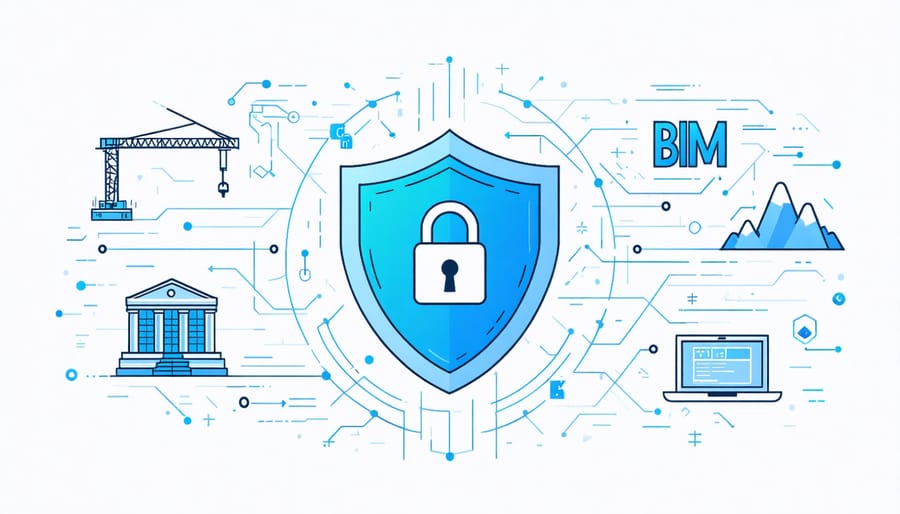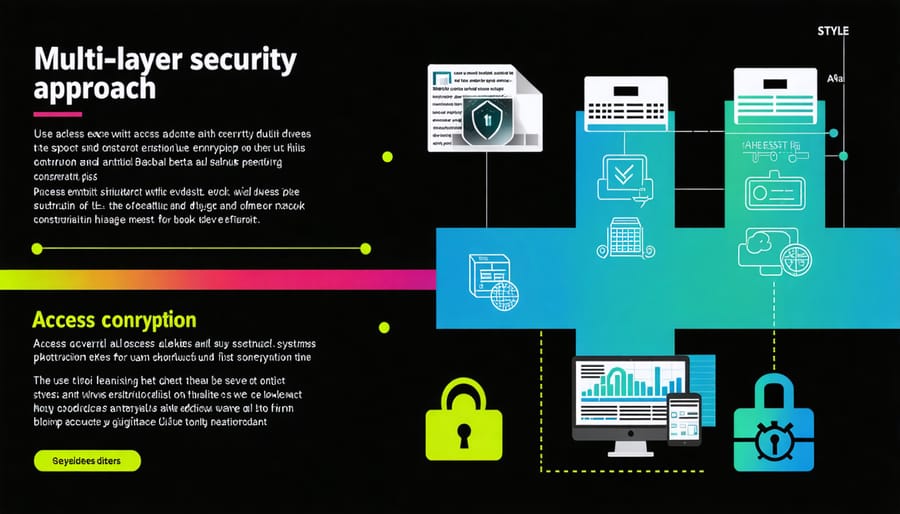In today’s digital construction landscape, protecting and managing project data has become as crucial as physical site security. Recent construction data breaches have cost the industry billions, exposing vulnerabilities in traditional data management approaches. Modern construction projects generate massive amounts of sensitive information – from BIM models and material specifications to contract documents and employee records – requiring robust, systematic protection protocols.
Advanced construction data management systems now integrate real-time collaboration capabilities with military-grade encryption, enabling seamless information flow while maintaining ironclad security. Leading contractors implementing these solutions report 40% faster document retrieval, 60% reduction in data-related errors, and near-complete elimination of unauthorized access incidents.
For construction executives and project managers, the challenge lies not just in selecting the right technology, but in creating a comprehensive data management framework that aligns with existing workflows while preparing for future digital transformation. This strategic approach to construction data management has become a critical differentiator, directly impacting project efficiency, risk mitigation, and competitive advantage in an increasingly digital industry.
The Digital Revolution in Construction Management
Key Construction Data Types
In modern construction projects, several key data types form the foundation of effective project management and execution. Building Information Modeling (BIM) models stand at the forefront, containing detailed 3D representations of structures along with associated metadata for components, materials, and specifications. These models serve as single sources of truth for project stakeholders.
Project schedules represent another critical data category, encompassing detailed timelines, resource allocation plans, and milestone tracking information. These are typically managed through specialized construction management software and integrate with other project elements.
Cost data encompasses everything from initial estimates and bids to ongoing expense tracking, change orders, and final reconciliation. This financial information requires careful management to maintain accuracy and audit trails.
Compliance documentation includes permits, safety records, certifications, and regulatory submissions. These documents must be carefully maintained and readily accessible for inspections and audits.
Quality control data, including inspection reports, material testing results, and defect logs, forms another essential category. This information helps maintain construction standards and supports warranty management.
Field data collected through mobile devices, IoT sensors, and daily reports provides real-time insights into project progress and potential issues.
Digital Collaboration Platforms
Modern construction projects increasingly rely on collaborative digital platforms that streamline data management and team communication. These cloud-based solutions enable real-time information sharing, document control, and project coordination across multiple stakeholders. Leading platforms like Procore, Autodesk Construction Cloud, and PlanGrid have transformed how construction teams handle project data, incorporating features such as BIM integration, digital drawings management, and automated workflows.
These platforms significantly enhance productivity by centralizing project information and enabling remote access to critical data. However, this digital transformation also necessitates robust digital risk management practices to protect sensitive project information. Construction firms must carefully evaluate platform security features, including user authentication, data encryption, and access controls.
The most effective digital collaboration platforms offer customizable permission settings, detailed audit trails, and seamless integration with existing construction management software. They also provide mobile capabilities for field teams, ensuring that critical project data remains accessible and secure across various devices and locations. This technological ecosystem has become essential for managing complex construction projects while maintaining data integrity and team efficiency.


Critical Security Threats in Construction Data
Cybersecurity Vulnerabilities
In today’s digital construction landscape, the industry faces increasingly sophisticated data security threats that can severely impact project delivery and compromise sensitive information. Common vulnerabilities include unauthorized access to project documentation, compromised Building Information Modeling (BIM) files, and breaches in financial transaction systems.
Recent industry studies reveal that construction firms experience an average of 3.5 security incidents annually, with 60% resulting in project delays and significant financial losses. These breaches often target cloud-based project management platforms, where contractors store critical documentation, specifications, and proprietary design information.
Notable security challenges include:
– Unsecured mobile devices accessing project data from job sites
– Weak authentication protocols in collaborative platforms
– Outdated software systems lacking current security patches
– Insufficient employee training on cybersecurity best practices
– Vulnerable Internet of Things (IoT) devices on construction sites
The impact of these vulnerabilities extends beyond immediate data loss. Construction firms report increased insurance premiums, damaged client relationships, and compromised competitive advantages following security breaches. Additionally, regulatory compliance violations can result in substantial fines and legal complications.
To mitigate these risks, construction companies must implement robust security protocols, including multi-factor authentication, regular security audits, and comprehensive data encryption strategies. Employee training programs and incident response plans are equally crucial for maintaining data integrity across construction operations.
Remote Work Security Challenges
The shift towards remote work in construction has introduced significant security challenges for data management. Construction firms must now secure sensitive project information across multiple locations, devices, and networks, while maintaining seamless collaboration among team members.
One of the primary concerns is unauthorized access to project data through unsecured networks. Site managers and field workers accessing crucial documents through mobile devices may connect through public Wi-Fi networks, potentially exposing confidential information to security breaches. To mitigate this risk, organizations must implement robust Virtual Private Network (VPN) solutions and multi-factor authentication protocols.
Mobile device management presents another critical challenge. With team members using personal devices for work purposes, organizations face increased risks of data leakage and compromised access controls. Construction firms must establish clear BYOD (Bring Your Own Device) policies and implement mobile device management solutions that separate personal and professional data.
Cloud security becomes paramount when managing distributed teams. While cloud platforms offer convenience and accessibility, they require careful configuration of access permissions and regular security audits. Organizations should implement role-based access control (RBAC) systems to ensure team members can only access information relevant to their responsibilities.
Additionally, remote work security demands enhanced training programs. Team members must understand proper data handling procedures, recognize potential security threats, and follow established protocols for sharing sensitive information across digital platforms.
Implementing Robust Data Security Measures

Access Control and Authentication
Access control and authentication form the cornerstone of secure construction data management, ensuring that sensitive project information remains protected while maintaining efficient workflow processes. A robust access control system implements role-based permissions, allowing project managers to assign specific access levels to team members based on their responsibilities and need-to-know basis.
Best practices include implementing multi-factor authentication (MFA) for all users accessing critical project data, especially when connecting remotely. This additional security layer typically combines something the user knows (password) with something they possess (mobile device) or biometric data.
Construction firms should maintain detailed access logs and conduct regular audits to monitor user activities and detect potential security breaches. Automated systems can flag unusual access patterns or unauthorized attempts, enabling quick response to security threats.
When setting up user permissions, follow the principle of least privilege, granting users only the minimum access required to perform their duties. This approach significantly reduces the risk of data breaches and unauthorized modifications to crucial project documents.
Regular password updates, strong password policies, and automatic session timeouts should be mandatory. For larger projects, consider implementing Single Sign-On (SSO) solutions to streamline access while maintaining security. Additionally, establish clear protocols for quickly revoking access when team members leave the project or organization.
Data Encryption Standards
In the modern construction industry, robust data encryption standards are essential for protecting sensitive project information, financial data, and intellectual property. The industry primarily employs AES (Advanced Encryption Standard) with 256-bit encryption for data at rest, ensuring that stored information remains secure across various digital platforms and devices.
For data in transit, construction firms typically implement TLS 1.3 (Transport Layer Security) protocols, which provide end-to-end encryption for information exchanged between project stakeholders, cloud services, and mobile devices on construction sites. This is particularly crucial when sharing BIM models, project schedules, and confidential contract documents.
Multi-layer encryption approaches have become standard practice, combining symmetric and asymmetric encryption methods. Symmetric encryption using shared keys provides efficient security for large datasets, while asymmetric encryption facilitates secure key exchange between parties. Construction companies often implement PKI (Public Key Infrastructure) systems to manage digital certificates and maintain secure communication channels between project participants.
Database encryption is another critical component, with transparent data encryption (TDE) being widely adopted to protect construction management databases. This ensures that sensitive information such as cost estimates, supplier details, and project specifications remains encrypted even during system maintenance or backup procedures.
Regular encryption key rotation and secure key management practices are essential elements of any construction data security strategy, helping organizations maintain compliance with data protection regulations while safeguarding valuable project assets.
Backup and Recovery Protocols
In construction data management, robust backup and recovery protocols are essential safeguards against data loss and system failures. Industry best practices recommend implementing a comprehensive 3-2-1 backup strategy: maintaining three copies of data, storing them on two different types of media, and keeping one copy off-site or in the cloud.
Critical project data should be automatically backed up at regular intervals, with frequency determined by project phase and data sensitivity. Daily incremental backups combined with weekly full backups ensure optimal protection while managing storage resources efficiently. Cloud-based solutions offer particular advantages for construction firms, providing geographical redundancy and accessibility from multiple project sites.
For effective disaster recovery, organizations should maintain detailed documentation of their IT infrastructure, including system configurations, software licenses, and user access protocols. Regular testing of recovery procedures is crucial, with quarterly drills recommended to verify system restoration capabilities and identify potential bottlenecks.
Version control systems should be integrated into backup protocols, especially for BIM models and project documentation. This ensures teams can recover not just the latest versions but also critical historical data points. Recovery Time Objectives (RTO) and Recovery Point Objectives (RPO) should be clearly defined based on project requirements and contractual obligations.
Implementation of automated monitoring systems can alert IT teams to backup failures or anomalies, enabling prompt intervention before data loss occurs. Additionally, encrypted backup storage protects sensitive project information from unauthorized access during the backup and recovery process.
Future-Proofing Your Data Management Strategy
As the construction industry continues to evolve digitally, staying ahead of emerging trends in data management is crucial for long-term success. Industry experts predict that by 2025, the volume of construction data will increase tenfold, driven by BIM adoption, IoT sensors, and digital twin technologies. To future-proof your data management strategy, organizations must embrace cloud-native solutions while maintaining robust security protocols.
Artificial Intelligence and Machine Learning are revolutionizing how construction data is processed and analyzed. These technologies enable predictive maintenance, automated risk assessment, and real-time project analytics. Forward-thinking companies are already implementing AI-powered data management systems that can automatically classify, organize, and protect sensitive information while providing actionable insights.
Blockchain technology is emerging as a potential game-changer for secure data sharing and verification. Its distributed ledger system offers immutable record-keeping for project documentation, contracts, and supply chain management. Early adopters are reporting improved transparency and reduced disputes in project delivery.
Edge computing is becoming increasingly relevant as construction sites generate more real-time data. By processing data closer to its source, edge computing reduces latency and bandwidth requirements while enhancing security through localized data protection measures.
To prepare for these technological advances, organizations should:
– Develop scalable data architecture that can accommodate growing data volumes
– Implement flexible security frameworks that can adapt to new threats
– Invest in staff training to maintain competency with emerging technologies
– Establish clear data governance policies that account for future regulations
– Regular audit and update security protocols to address evolving cyber threats
Integration capabilities will be crucial as new technologies emerge. Ensure your data management systems can communicate with various platforms and tools while maintaining security integrity. Consider adopting API-first approaches that facilitate secure data exchange between different systems.
Sustainability considerations are also becoming integral to data management strategies. Energy-efficient data storage solutions and environmentally conscious processing methods will become standard requirements in the industry.
Effective construction data management and security is no longer optional in today’s digital construction landscape – it’s a critical necessity for project success and organizational sustainability. By implementing robust security protocols, investing in secure data management systems, and fostering a security-conscious culture, construction firms can significantly reduce their vulnerability to data breaches and cyber threats.
Key action steps for improving construction data security include conducting regular security audits, implementing multi-factor authentication across all platforms, establishing clear data access protocols, and maintaining comprehensive backup systems. Training staff at all levels on security best practices and potential threats should be prioritized as part of ongoing professional development.
Construction companies should also consider adopting advanced encryption methods for sensitive project data, implementing automated monitoring systems for unusual data access patterns, and regularly updating their incident response plans. Partnering with cybersecurity experts who understand the unique challenges of the construction industry can provide valuable guidance in developing and maintaining robust security frameworks.
Remember that data security is an ongoing process rather than a one-time implementation. Regular assessment and updates of security measures, combined with vigilant monitoring and prompt response to potential threats, will help ensure the continued protection of valuable construction data assets. By taking these proactive steps, construction firms can better safeguard their digital infrastructure while maintaining efficient operations and protecting client interests.

